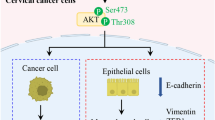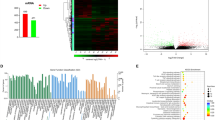Abstract
Background
Placenta specific 8 (PLAC8) plays an important role in many different cellular processes and human diseases, including multiple types of cancer. However, the functional role of PLAC8 in clear cell renal cell carcinoma (ccRCC) has never been elucidated.
Methods
PLAC8 mRNA expression was investigated in 31 pairs of fresh ccRCC tumor tissues and matched adjacent non-tumor tissues by RT-qPCR and confirmed by analyzing the TCGA KRCC dataset which contains RNA-seq data of 534 ccRCC and 72 solid normal tissues. Protein level of PLAC8 expression was also investigated using immunohistochemistry in 129 ccRCC samples. Correlations with clinicopathological factors and overall survival were analyzed. To examine its effect on the biological activity, PLAC8 siRNAs were transfected into ccRCC cells. Cell proliferation was assessed by CCK8 cell viability assays, clone formation assays, and EdU incorporation assays. Cell invasion was examined using transwell assays. RNA sequencing was then performed to further elucidate the mechanisms by which PLAC8 regulates the cancer.
Results
PLAC8 expression was positively correlated with tumor size, metastasis, and clinical stage of ccRCC. Additionally, high PLAC8 expression was closely associated with a shorter overall survival time. Knockdown of PLAC8 with siRNAs significantly reduced the proliferation and invasion of RCC cells and increased the sensitivity of RCC cells to cisplatin. RNA-seq analysis revealed that knockdown of PLAC8 down-regulated the expression of a panel of inflammatory mediators, which suggested that PLAC8 is associated with the ccRCC inflammatory microenvironment. Patients with high expression of PLAC8 had a significantly higher number of infiltrative lymphocytes than patients with low expression of PLAC8.
Conclusion
Our findings suggest that PLAC8 may be a potential prognostic indicator and therapeutic target for ccRCC.






Similar content being viewed by others
References
McLaughlin JK, Lipworth L, Tarone RE (2006) Epidemiologic aspects of renal cell carcinoma. Semin Oncol 33(5):527–533. doi:10.1053/j.seminoncol.2006.06.010
Schachter LR, Cookson MS, Chang SS, Smith JA Jr, Dietrich MS, Jayaram G, Herrell SD (2007) Second prize: frequency of benign renal cortical tumors and histologic subtypes based on size in a contemporary series: what to tell our patients. J Endourol 21(8):819–823. doi:10.1089/end.2006.9937
Cheng L, Zhang S, MacLennan GT, Lopez-Beltran A, Montironi R (2009) Molecular and cytogenetic insights into the pathogenesis, classification, differential diagnosis, and prognosis of renal epithelial neoplasms. Hum Pathol 40(1):10–29. doi:10.1016/j.humpath.2008.09.009
Cheville JC, Lohse CM, Zincke H, Weaver AL, Blute ML (2003) Comparisons of outcome and prognostic features among histologic subtypes of renal cell carcinoma. Am J Surg Pathol 27(5):612–624
Gudbjartsson T, Hardarson S, Petursdottir V, Thoroddsen A, Magnusson J, Einarsson GV (2005) Histological subtyping and nuclear grading of renal cell carcinoma and their implications for survival: a retrospective nation-wide study of 629 patients. Eur Urol 48(4):593–600. doi:10.1016/j.eururo.2005.04.016
Patard JJ, Leray E, Rioux-Leclercq N, Cindolo L, Ficarra V, Zisman A, De La Taille A, Tostain J, Artibani W, Abbou CC, Lobel B, Guille F, Chopin DK, Mulders PF, Wood CG, Swanson DA, Figlin RA, Belldegrun AS, Pantuck AJ (2005) Prognostic value of histologic subtypes in renal cell carcinoma: a multicenter experience. J Clin Oncol Off J Am Soc Clin Oncol 23(12):2763–2771. doi:10.1200/jco.2005.07.055
Tanaka TS, Jaradat SA, Lim MK, Kargul GJ, Wang X, Grahovac MJ, Pantano S, Sano Y, Piao Y, Nagaraja R, Doi H, Wood WH 3rd, Becker KG, Ko MS (2000) Genome-wide expression profiling of mid-gestation placenta and embryo using a 15,000 mouse developmental cDNA microarray. Proc Natl Acad Sci USA 97(16):9127–9132
Galaviz-Hernandez C, Stagg C, de Ridder G, Tanaka TS, Ko MS, Schlessinger D, Nagaraja R (2003) Plac8 and Plac9, novel placental-enriched genes identified through microarray analysis. Gene 309(2):81–89
Rissoan MC, Duhen T, Bridon JM, Bendriss-Vermare N, Peronne C, de Saint Vis B, Briere F, Bates EE (2002) Subtractive hybridization reveals the expression of immunoglobulin-like transcript 7, Eph-B1, granzyme B, and 3 novel transcripts in human plasmacytoid dendritic cells. Blood 100(9):3295–3303. doi:10.1182/blood-2002-02-0638
Ledford JG, Kovarova M, Koller BH (2007) Impaired host defense in mice lacking ONZIN. J Immunol 178(8):5132–5143
Jimenez-Preitner M, Berney X, Uldry M, Vitali A, Cinti S, Ledford JG, Thorens B (2011) Plac8 is an inducer of C/EBPbeta required for brown fat differentiation, thermoregulation, and control of body weight. Cell Metab 14(5):658–670. doi:10.1016/j.cmet.2011.08.008
Jimenez-Preitner M, Berney X, Thorens B (2012) Plac8 is required for white adipocyte differentiation in vitro and cell number control in vivo. PLoS ONE 7(11):e48767. doi:10.1371/journal.pone.0048767
Johnson RM, Kerr MS, Slaven JE (2012) Plac8-dependent and inducible NO synthase-dependent mechanisms clear Chlamydia muridarum infections from the genital tract. J Immunol 188(4):1896–1904. doi:10.4049/jimmunol.1102764
Li C, Ma H, Wang Y, Cao Z, Graves-Deal R, Powell AE, Starchenko A, Ayers GD, Washington MK, Kamath V, Desai K, Gerdes MJ, Solnica-Krezel L, Coffey RJ (2014) Excess PLAC8 promotes an unconventional ERK2-dependent EMT in colon cancer. J Clin Invest 124(5):2172–2187. doi:10.1172/JCI71103
Ledford JG, Kovarova M, Jania LA, Nguyen M, Koller BH (2012) ONZIN deficiency attenuates contact hypersensitivity responses in mice. Immunol Cell Biol 90(7):733–742. doi:10.1038/icb.2011.107
Zou L, Chai J, Gao Y, Guan J, Liu Q, Du JJ (2016) Down-regulated PLAC8 promotes hepatocellular carcinoma cell proliferation by enhancing PI3K/Akt/GSK3beta/Wnt/beta-catenin signaling. Biomed Pharmacother 84:139–146. doi:10.1016/j.biopha.2016.09.015
Kaistha BP, Lorenz H, Schmidt H, Sipos B, Pawlak M, Gierke B, Kreider R, Lankat-Buttgereit B, Sauer M, Fiedler L, Krattenmacher A, Geisel B, Kraus JM, Frese KK, Kelkenberg S, Giese NA, Kestler HA, Gress TM, Buchholz M (2016) PLAC8 localizes to the inner plasma membrane of pancreatic cancer cells and regulates cell growth and disease progression through critical cell-cycle regulatory pathways. Cancer Res 76(1):96–107. doi:10.1158/0008-5472.can-15-0216
Wu X, Lin Y, Shi L, Huang Y, Lai C, Wang Y, Zhang M, Wang S, Heng B, Yu G, Du X, Fang L, Fu Y, Chen J, Guo Z, Su Z, Wu S (2015) Upregulation of centromere protein H is associated with progression of renal cell carcinoma. J Mol Histol 46(4–5):377–385. doi:10.1007/s10735-015-9635-2
Wang Y, Chen F, Zhao M, Yang Z, Zhang S, Ye L, Gao H, Zhang X (2016) MiR-107 suppresses proliferation of hepatoma cells through targeting HMGA2 mRNA 3′UTR. Biochem Biophys Res Commun 480(3):455–460. doi:10.1016/j.bbrc.2016.10.070
Fukuda H, Nakamura S, Chisaki Y, Takada T, Toda Y, Murata H, Itoh K, Yano Y, Takata K, Ashihara E (2016) Daphnetin inhibits invasion and migration of LM8 murine osteosarcoma cells by decreasing RhoA and Cdc42 expression. Biochem Biophys Res Commun 471(1):63–67. doi:10.1016/j.bbrc.2016.01.179
Miao X, Luo Q, Qin X, Guo Y, Zhao H (2015) Genome-wide mRNA-seq profiling reveals predominant down-regulation of lipid metabolic processes in adipose tissues of Small Tail Han than Dorset sheep. Biochem Biophys Res Commun 467(2):413–420. doi:10.1016/j.bbrc.2015.09.129
Rogulski K, Li Y, Rothermund K, Pu L, Watkins S, Yi F, Prochownik EV (2005) Onzin, a c-Myc-repressed target, promotes survival and transformation by modulating the Akt-Mdm2-p53 pathway. Oncogene 24(51):7524–7541. doi:10.1038/sj.onc.1208897
Wu SF, Huang Y, Hou JK, Yuan TT, Zhou CX, Zhang J, Chen GQ (2010) The downregulation of onzin expression by PKCepsilon-ERK2 signaling and its potential role in AML cell differentiation. Leukemia 24(3):544–551. doi:10.1038/leu.2009.280
Mourtada-Maarabouni M, Watson D, Munir M, Farzaneh F, Williams GT (2013) Apoptosis suppression by candidate oncogene PLAC8 is reversed in other cell types. Curr Cancer Drug Targets 13(1):80–91
Chen W, Zheng R, Baade PD, Zhang S, Zeng H, Bray F, Jemal A, Yu XQ, He J (2016) Cancer statistics in China, 2015. CA Cancer J Clin 66(2):115–132. doi:10.3322/caac.21338
Mai KT, Landry DC, Robertson SJ, Commons AS, Burns BF, Thijssen A, Collins J (2001) A comparative study of metastatic renal cell carcinoma with correlation to subtype and primary tumor. Pathol Res Pract 197(10):671–675. doi:10.1078/0344-0338-00144
Bonsib SM (2006) Renal lymphatics, and lymphatic involvement in sinus vein invasive (pT3b) clear cell renal cell carcinoma: a study of 40 cases. Mod Pathol 19(5):746–753. doi:10.1038/modpathol.3800589
Kinsey C, Balakrishnan V, O’Dell MR, Huang JL, Newman L, Whitney-Miller CL, Hezel AF, Land H (2014) Plac8 links oncogenic mutations to regulation of autophagy and is critical to pancreatic cancer progression. Cell Rep 7(4):1143–1155. doi:10.1016/j.celrep.2014.03.061
Cavallo F, De Giovanni C, Nanni P, Forni G, Lollini PL (2011) 2011: the immune hallmarks of cancer. Cancer Immunol Immunother CII 60(3):319–326. doi:10.1007/s00262-010-0968-0
Funding
This study was funded by The National Key Research and Development Program of China (No. 2016YFC1305700), and Major Research Fund for the People’s Livelihood of Guangzhou Science and Technology Plan (No. 2011Y-00003).
Author information
Authors and Affiliations
Corresponding author
Ethics declarations
Conflict of interest
The authors declare that they have no conflict of interest.
Ethical approval
All procedures performed in studies involving human participants were in accordance with the ethical standards of the institutional research committee and with the 1964 Helsinki Declaration and its later amendments or comparable ethical standards.
Informed consent
Informed consent was obtained from all individual participants included in the study.
Electronic supplementary material
Below is the link to the electronic supplementary material.
Rights and permissions
About this article
Cite this article
Shi, L., Xiao, L., Heng, B. et al. Overexpression of placenta specific 8 is associated with malignant progression and poor prognosis of clear cell renal cell carcinoma. Int Urol Nephrol 49, 1165–1176 (2017). https://doi.org/10.1007/s11255-017-1578-y
Received:
Accepted:
Published:
Issue Date:
DOI: https://doi.org/10.1007/s11255-017-1578-y




